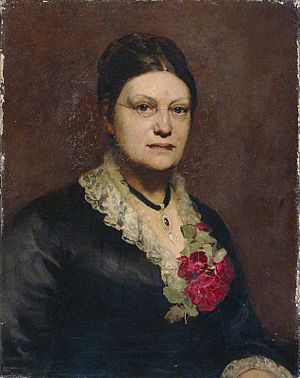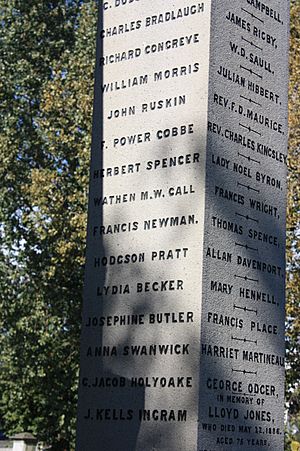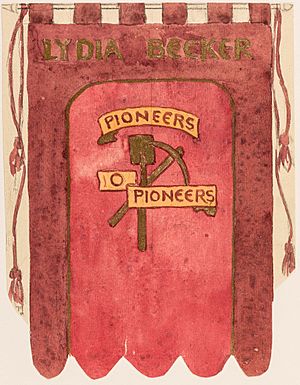Lydia Becker facts for kids
Quick facts for kids
Lydia Becker
|
|
|---|---|

Portrait by fellow suffragist Susan Isabel Dacre
|
|
| Born |
Lydia Ernestine Becker
24 February 1827 Cooper Street, Manchester, Lancashire, England
|
| Died | 18 July 1890 (aged 63) Aix-les-Bains, Savoie, France
|
| Nationality | British |
Lydia Ernestine Becker (born February 24, 1827 – died July 18, 1890) was a very important leader in the early movement for women's voting rights in Britain. This movement is called the suffrage movement. She was also a keen amateur scientist who loved biology and astronomy.
Lydia helped make Manchester a key place for the suffrage movement. With Richard Pankhurst, she helped the first woman vote in a British election. She is also remembered for starting and publishing the Women's Suffrage Journal from 1870 to 1890. This journal shared news and ideas about women's rights.
Contents
Lydia Becker's Early Life and Science Interests
Lydia Becker was born in Manchester, England. She was the oldest daughter of Hannibal Becker. Like many girls at that time, she was taught at home. Lydia was very curious and loved to learn.
From the 1850s, she studied botany (the study of plants) and astronomy (the study of stars and planets). In 1862, she won a gold medal for a paper she wrote about growing plants. Her uncle encouraged her interest in science. Five years later, she started the Ladies' Literary Society in Manchester.
Lydia wrote letters to the famous scientist Charles Darwin. She even convinced him to send a paper to her society. She sent Darwin many plant samples from around Manchester. She also sent him her small book, Botany for Novices (1864). Lydia was one of many women who helped Darwin with his scientific work. She was especially interested in plants that had both male and female parts.
Lydia was also recognized for her own science work. In the 1860s, she won a national prize for a collection of dried plants. She had found a special way to dry them so they kept their original colors. In 1869, she gave a paper about plants to the British Science Association. Even though botany was important to her, her work for women's voting rights became the main focus of her life. She also worked to encourage science education for girls and women.
Fighting for Women's Voting Rights
In 1866, Lydia Becker went to a meeting where she heard a paper by Barbara Bodichon about why women should be allowed to vote. This inspired her greatly. In January 1867, she organized the first meeting of the Manchester Women's Suffrage Committee. This was one of the first groups of its kind in England. There, she met Dr. Richard Pankhurst, who later married Emmeline Pankhurst.
A few months later, a shop owner named Lilly Maxwell accidentally appeared on the list of voters in Manchester. Lydia Becker saw this as a great chance to get attention for the cause. She went with Lilly to the polling station, and Lilly was allowed to vote. Lydia then encouraged other women who owned homes to ask to be put on the voter lists. Their requests were taken to court, but the case was not successful.
On April 14, 1868, the first public meeting of the National Society for Women's Suffrage was held in Manchester. Lydia Becker was one of the main speakers. She proposed that women should have the right to vote on the same terms as men.
After this, Lydia traveled around northern cities, giving talks for the society. In June 1869, Lydia and other campaigners successfully helped women get the right to vote in local city elections. In 1870, she was one of four women elected to the Manchester School Board, where she worked until she died.
In the same year, Lydia and her friend Jessie Boucherett started the Women's Suffrage Journal. They also began organizing speaking tours for women, which was very unusual in Britain at the time. In 1874, a fifteen-year-old Emmeline Pankhurst attended her first public meeting for women's voting rights, organized by Lydia Becker.
The Journal became the most popular publication about women's voting rights in 19th-century Britain. It shared speeches from all over the country. Lydia published letters from both her supporters and those who disagreed with her.
In 1880, Lydia Becker and her co-workers campaigned in the Isle of Man for women to vote in their local elections. They were successful! Women gained voting rights in the Isle of Man in March 1881. Lydia became the head of the Central Committee of the National Society for Women's Suffrage. This group worked to convince Parliament to change the laws.
Lydia Becker had some different ideas from other early feminists. She believed there was no natural difference in how smart men and women were. She strongly supported a school system where boys and girls learned the same things. She also argued more strongly for unmarried women to have the right to vote. She felt that single women and widows needed the vote more than married women who might have financial support from their husbands. Because of these views, she was often made fun of in newspapers.
Lydia Becker's Death and Legacy
In 1890, Lydia Becker visited a spa town called Aix-les-Bains in France. She became ill there and died from diphtheria at the age of 63.
After she died, the people who worked on the Women's Suffrage Journal decided to stop publishing it. They felt they could not continue without her leadership.
Memorials to Lydia Becker
A collection of books by women, including some from Lydia's friend Helen Blackburn, was placed in two special bookcases. These bookcases were decorated with paintings of Lydia Becker and Caroline Ashurst Biggs, who had also led the Central Committee of the National Society for Women's Suffrage. These bookcases were given to Girton College and can still be seen today.
Lydia Becker's name is carved on the Reformers Memorial in Kensal Green Cemetery in London. Her name is also on her father's gravestone in the churchyard of St James, Altham in Lancashire. A plaque remembering her life is located near the Moorfield Colliery Memorial in Altham.
Lydia Becker's name and image are also etched on the base of the statue of Millicent Fawcett in Parliament Square, London. This statue honors a very important leader in the women's suffrage movement.
In Paris, France, there is a street named after her, called the allée Lydia-Becker. It is near Montmartre.
See also
 In Spanish: Lydia Becker para niños
In Spanish: Lydia Becker para niños



